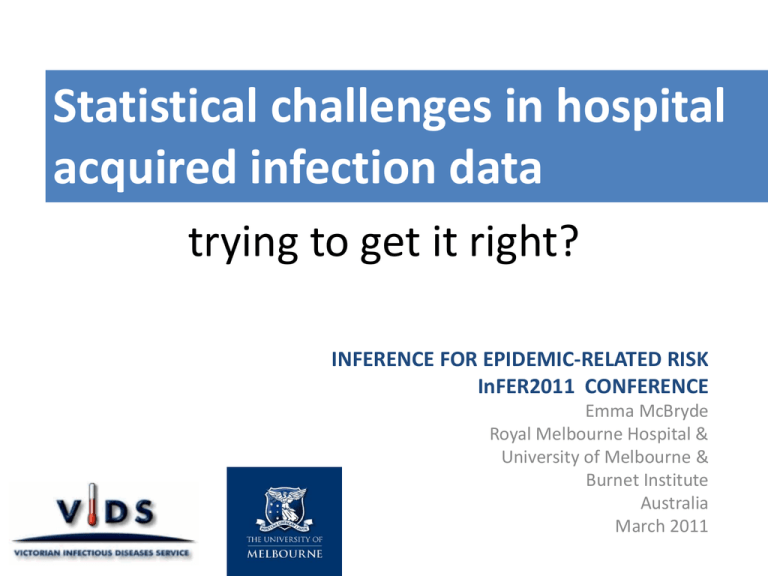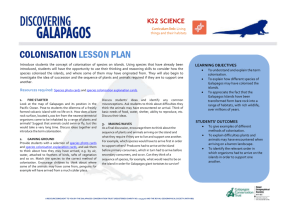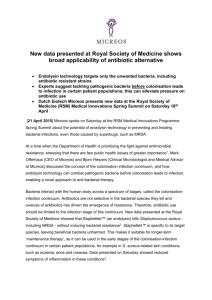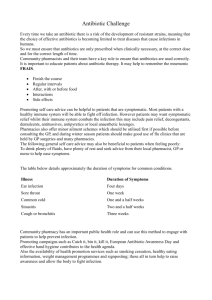Statistical challenges in hospital acquired infection data trying to get it right?
advertisement

Statistical challenges in hospital
acquired infection data
trying to get it right?
INFERENCE FOR EPIDEMIC-RELATED RISK
InFER2011 CONFERENCE
Emma McBryde
Royal Melbourne Hospital &
University of Melbourne &
Burnet Institute
Australia
March 2011
RMH
Intensive Care
Methicillin-resistant
Staphylococcus aureus
Hospital acquired infections
HAIs
•
•
•
•
•
High morbidity
High mortality
Greater duration of stay*
Greater cost
…. Large burden
Engemann, J. J., Y. Carmeli, et al. (2003). "Adverse clinical and economic outcomes attributable to methicillin
resistance among patients with Staphylococcus aureus surgical site infection." Clin Infect Dis 36(5): 592-598
Challenges in statistical inference
• Serial dependence of transmission data
• Data have a complex relational structure
– bidirectional causality
– confounding
• Experimental options are limited
– randomised Control Trial infeasible, unethical
– may not answer any valuable question
• Interrupted Time Series
– has some advantages
– numerous ways they can lead to incorrect inference
• Partial observation
Challenges in statistical inference
• Serial dependence of transmission data
• Data have a complex relational structure
– bidirectional causality
– confounding
• Experimental options are limited
– randomised Control Trial infeasible, unethical
– may not answer any valuable question
• Interrupted Time Series
– has some advantages
– numerous ways they can lead to incorrect inference
• Partial observation
Basic science informs transmission models
• Hand to hand (contact) transmission is the commonest
way the Staphylococcus aureus spreads
• In the ICU, most of patient to patient transmission is
from colonised to uncolonised patients via the hands
of HCW
• Environmental contamination certainly plays a role in
some hospital pathogens
• Must be considered if it is an influential transmission
dynamic driver and particularly if the environment
remains contaminated after the colonised patient is
gone
Ross-MacDonald Model
HCW
Serial Dependence in data
• RCT: contaminated by effect of treatment in
neighbouring patients
• Cluster RCT; ok but
– feasibility how many similar ICUs are there?
– some effects can’t be ethically compared in RCT
• Hand hygiene, for example
– inference can limited (variance of events >> mean)
• Interrupted time series is a more convenient
alternative but has potential to lead to false
inference
ITS common mistakes
• Wait until there is an epidemic
• Institute numerous measures at once
• Disregard
– important confounding effects
– that observations are partial
– dependency in the data
30
Number of colonised patients
25
20
15
10
5
0
0
100
200
300
400
500
600
Time (days)
700
800
Simulation SI model
30
Number of colonised patients
25
20
15
10
5
0
0
200
400
600
800
1000
Time (days)
1200
1400
1600
1800
Challenges in statistical inference
• Serial dependence of transmission data
• Data have a complex relational structure
– bidirectional causality
– confounding
• Experimental options are limited
– randomised Control Trial infeasible, unethical
– may not answer any valuable question
• Interrupted Time Series
– has some advantages
– numerous ways they can lead to incorrect inference
• Partial observation
Length of stay-> Infection
• Estimate effect of hospital infection on length
of stay
• Confounds effect of other covariates on
infection
Many solutions
• Different approaches taken
– Competing risk models
– Instrumental variables
• Survival analysis with discharge day as the “failure
event”
– Infection and other known factors as covariates
– If day of infection is known, can model this as a timedependent covariate
• Assumes the hazard ratio due to infection on discharge
odds per day is constant over time
• Data imputation (risk model for day of acquisition) if
time of infection is unknown
Some common mistakes
• Take LOS as a “time invariant” covariate or binary
covariate
“risk factors for the development of HA-MRSA on
multivariate analysis multivariate analysis
included length of stay >7 days”
• Use a statistical model that allows LOS to
confound other potential risk factors for HAI,
such as antibiotics
A
0.1
A
Infec
Uncol
0.1
10 days
Infec
50 days
Results of simple univariate regression
PArameter
True value
Estimated value
Effect of antibiotics on
infection risk
Odds Ratio=1
OR=1.05 (^7)
Hazard is not constant
Marshall, C., D. Spelman, et al. (2009). "Daily hazard of acquisition of methicillinresistant Staphylococcus aureus infection in the intensive care unit." Infect Control
Hosp Epidemiol 30(2): 125-129.
Challenges in statistical inference
• Serial dependence of transmission data
• Data have a complex relational structure
– bidirectional causality
– confounding
• Experimental options are limited
– randomised Control Trial infeasible, unethical
– may not answer any valuable question
• Interrupted Time Series
– has some advantages
– numerous ways they can lead to incorrect inference
• Partial observation
Partial observation in hospital data
• Colonisation unseen
– date of colonisation
– Presence of colonisation
• Missing data
– Infections not correctly diagnosed, for example
• When and from whom the transmission occurred
• With perfect data we could learn a lot about
transmission
• Solutions?
– Assume perfect data
• Underestimate true effects, overestimate false effect
Missing data imputation
• Impute missing data using the partial likelihood
given the state of the model and the partial
likelihood values as the sampling distribution
• Calculating likelihood is difficult on observed data
– observed infection times
• Fully observed dataset is readily soluble using a
model
– actual infection times
RMH
Does detection and isolation work?
Study
• Planned ITS at Melbourne Hospital Intensive Care Unit
• Pre-intervention 15 months
– standard care
– add swabs form MRSA on admission, discharge and Mondays,
Thursdays
– no reporting of results back to treating team
– no routine isolation for MRSA colonisation (unethical?)
• Post-intervention 15 months
– Swabs and rapid PCR, returned within hours, but only on swab
days
– Report results of colonised patients, within the day
– Patient isolation; add in contact precautions, put sign on patient
room, aprons and gloves, single room (or cohorting)
Complexities
• Censored data; 3-4 days between swabs
• Covariates
– Patient factors: age, treating unit, risk of death
– Ward factors: infection control compliance
– Colonised patients: new versus old, antibiotic
exposure
Statistical model: hazard of colonisation
• Patient factors: antibiotic use, age, sex, admitting unit
• Colonised patients,
– Total number or all or nothing
– New colonisation or known to be colonised
– Antibiotic exposure
• Ward factors:
– staff ratio,
– adherence to infection control precautions;
• Treatment (phase of trial)
• Nuisance?
– Baseline hazard changes due to time since admission
Results: segmental regression model
0.015
Incident colonisations
0.01
0.005
0
0
5
10
15
Time (months)
20
25
30
Segmented regression
•
•
•
•
Negative binomial regression
4 parameters
Using vague priors
Estimated expected rate at end of intervention
compared with change-point
• Estimated expected rate at end compared
with extrapolated rate
Segmented regression model:
posteriors for change in MRSA rates
100
250
90
80
200
70
60
150
50
40
100
30
20
50
10
0
-0.02
-0.015
-0.01
-0.005
Inferred diff expectaion
0
0.005
0.01
Change in MRSA incidence rate
During phase 2
0
-10
-8
-6
-4
-2
Actual difference in expectaion
0
2
-3
Change in MRSA incidence rate
During phase 2
x 10
Back to the richer dataset
Making most out of the data
• first attempts at incorporating full patient
histories
• Just concentrating on colonisation pressure
(the numberof other patients on the ward
who were colonised)
– Reed-Frost
– Greenwood
• Phase
• Interaction between phase and colonisation
Mathematical model
S
I
S
I
Q
Method of likelihood estimation
• Piecewise hazard
– Time interval of one day
• Hazard calculated based on patient factors,
ward factors, phase of intervention and
colonised patient factors
• Hazard of a transmission for patient p on day t
given data, augmented data (exact
transmission times of patients) and
parameters
Day of acquisition was imputed using partial likelihood:
Components of the likelihood that depend on the imputed value
Time
Method of data augmentation: MCMC
• Calculate likelihood and update augmented
dataset, using a Gibbs step
• Recalculate likelihood update parameters,
using a Metropolis, Metropolis-Hastings
Assumptions
• Fully sensitive test
• New colonisation in first 48 hours must be
pre-colonised
• Individual Infectiousness unchanged with
time, except in presence of time dependent
covariate = antibiotic use
• All of these assumptions could be relaxed
Methods
Effect of phase 2
Factors included
• Colonised patients
• phase of study
• Phase x colonised
• Alone
• On colonised
S
I
background
Q
Univariate
Multivariate
I(Colonisation>0 )
Greenwood
1.56
4.1 (1.04-15.8)
phase
0.40 (0.25-0.64)
0.63 (0.32-1.2)
Phase*colonisation
1.02(0.78-1.34)
0.41 (0.20-0.95)
Some more results
• Patient factors
– Use of anaerobic activity antibiotics
• Colonised patient factors
– Antibiotic use is not estimated to be important
Conclusions
• The rapid detection and isolation intervention led
to a reduced risk of MRSA colonisation,
particularly in the presence of colonised patient
but also when no known colonised patient was in
the ward
• Other risk factors include anaerobic antibiotics
• Further developments
–
–
–
–
Allow for fully undetected acquisitions
Look at the PFGE typing data
Look at physical space; bed numbers
Individual Infectiousness unchanged with time
Acknowledgements
•
•
•
•
Dr Caroline Marshall
RN Leanne Redl
NHMRC Grant #454495
Fairfield photo collection
0.015
Incidence
0.01
0.005
0
0
5
10
15
Time (months)
20
25
30
The ORION statement: guidelines for transparent reporting of outbreak reports and
intervention studies of nosocomial infection
Unless outcomes are independent, statistical approaches able to account
for dependencies in the outcome data should be
used, adjusting, where necessary, for potential confounders.
Model
•
•
•
•
•
•
v1=unifrnd(10, 20, 1000, 1);
los=infcontin1+randn(size(infcontin1));
v2=infcontin1+randn(size(los))+los;
Given v2, v1 has no effect on los
V1 is functionally related to v2
V1
v2
The effect of v1 on los will show the direct
effect of v2 on los
los
•
•
•
•
•
•
•
•
•
•
regress ( infcontin2, infcontin1)
2.0032
regress (los, infcontin2)
0.5008
regress (los, [infcontin1, infcontin2])
-0.0370
0.5192
regress (los, infcontin1)
1.0032=answer
regress (infcontin1 ,[los, infcontin1])
• 1.0108
•
0.9872
0.9
0.8
0.7
incidence per 100 beddays
full compliance with isolation
0.6
0.5
0.4
0.3
0.2
0.1
0
0
2
4
6
8
Month of phase 2 of study
10
12
14
Problem with this approach
• Type 2 errors
– Lose information from the data
– Loss of power to detect a true difference
– Loss of important cofactors in the analysis
• Type 1 errors
– Overstate an effect due to clustered data and high
variance/mean
• log(∆(t|X))=log(∆ 0)+beta1 X(t)
+beta2Y(t)+beta3(Wt)
• Likelihood infection day t using a piecewize
hazard function
• S(t)=λt exp{-Σ λi }
(i=1, t-1)
Model
u 0
u0
Uncolonised patients not
receiving antibiotics
Pu0
u0
u1
u1
Uncolonised patients
receiving antibiotics
Pu1
u1
p1 p1 (1 ) H c / N h
c0
c 0
c0
Colonised patients not
receiving antibiotics
Pc0
c1
Colonised patients
receiving antibiotics
Pc1
c1
c1
e1 Pc1 / N p
e 0 Pc 0 / N p
p 0 h 0 Pc 0 / N p
p1 h1 ( Pc1 / N p E )
Uncontaminated HCW
Hu
Hc
Environmental
contamination
E
eh H c / N h
Contaminated HCW
Hc
Change in transmission parameter
Challenges in statistical inference
• Serial dependence of transmission data
• Data have a complex relational structure
– bidirectional causality
– confounding
• Experimental options are limited
– randomised Control Trial infeasible, unethical
– may not answer any valuable question
• Interrupted Time Series
– has some advantages
– numerous ways they can lead to incorrect inference
• Partial observation
Univariate
I(Colonisation>0 )
Greenwood
Multivariate
4.1 (1.04-15.8)
Colonisation
Reed Frost
1.10 (0.72- 1.69)
phase
0.63 (0.32-1.2)
0.42 (0.23-0.75)
Phase*colonisation
0.41 (0.20-0.95)
1.0 (0.64 -1.63)
0.015
Incidence
0.01
0.005
0
0
5
10
15
Time (months)
20
25
30
Hidden Markov Model
.
Hidden states: number colonised
Observations: number detected
Two components to the HMM
horizontal component: transition model
vertical component: observation model
.
MacDonald and Zucchini, Hidden Markov Models for Discrete Valued Time Series
Ananda-Rajah, M. R., E. S. McBryde, et al. (2010). "The role of general quality improvement
measures in decreasing the burden of endemic MRSA in a medical-surgical intensive care unit."
Intensive Care Med 36(11): 1890-1898.








